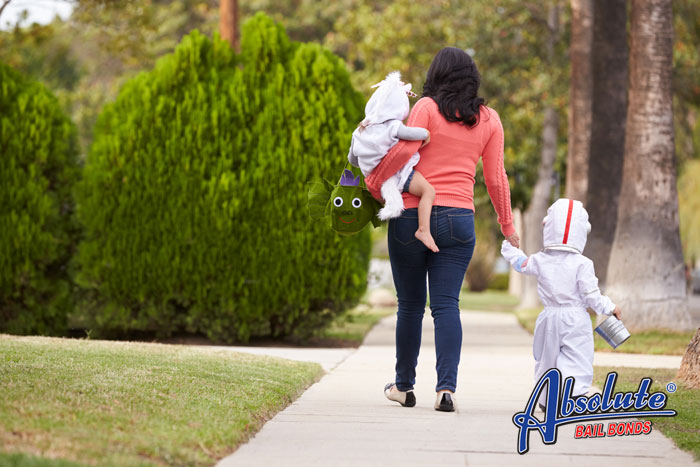
Trick-or-Treat Safety
Finally! Halloween is here. Not only does that mean cooler weather, pumpkin spice coffee, and an excuse to snuggle up with a good book rather than going out, kid will tell you that it’s time for free candy.
While kids love trick-or-treating, parents often have mixed feelings about the popular activity. Yes, it’s great to see how excited your kids get each year. The problem is that each year, parents worry how they will keep their child safe while they go from one house to another.
The good news is that there are things you can do to insure trick-or-treat safety while also allowing your children free rein to enjoy the holiday.
Make sure your children are visible, even if they’re out after dark. This isn’t complicated. Simply arm your child with a flashlight, and incorporate some flashing lights and reflective strips into their costume.
Remind your child about the rules of the road. Kids are so excited about being dressed up and obtaining as much free candy as possible, that they can easily forget things like watching for traffic. Before they head out to trick-or-treat it’s really important to remind them that they have to be respectful of motorist who are driving along the streets.
Trick-or-treat as either a family or friend unit. Instead of sending your child out on their own to trick-or-treat, make this an opportunity to make some excellent family memories and go out with your children. If work or life makes it impossible for you to join in the trick-or-treating fun, arrange for your child to go out with friends or other family members. Your child is far safer in a group than they are by themselves. Make sure a responsible adult will be watching over your children the entire time they are trick-or-treating.
Your children will want to eat their candy right away, but encourage them to wait until you get home. Waiting gives you an opportunity to inspect their candy and make sure it hasn’t been tampered with, plus it means your child isn’t potentially stopping in the middle of intersections in order to snatch a sugary treat.
Covid-19 is still a concern so make sure you keep a bottle of hand sanitizer on you and frequently apply it to your child’s hands. Remind them not to touch their face until they’re home and able to thoroughly wash their hands.
What steps are you taking to keep your child safe while trick-or-treating this holiday season?

The Difference Between a State and Federal Warrant
Most of us know that the police can’t simply walk into our homes and start searching it unless you’ve given them permission to do so, or if they’ve gone through the correct legal channels and acquired a warrant.
The same is true when it comes to arrests. While there are some exceptions, such as drunk driving, you usually can’t be arrested unless the police have an actual arrest warrant.
What you might not know is that there are both state/local arrest warrants and federal arrest warrants.
The biggest difference between a federal and state/local warrant is the law enforcement agency that is involved in your case.
If a federal warrant has been issued for your arrest, it means that you’re a suspect in a federal crime. To obtain a federal warrant, the agency working on the case must present a federal judge with sufficient evidence that you potentially committed the crime and that the crime is indeed a federal matter.
In some situations, trying to determine if a case is federal or state can be complicated. When this happens, a joint task force that consists of both federal agents and state officers is formed. The joint task force not only allows the different agencies to pool talent and resources but also makes it easier to obtain warrants.
How you should behave if there is a warrant for your arrest depends on how you learn about this information.
If you have heard (or suspect) that an arrest warrant has been issued, but the police haven’t actually knocked on your door, don’t even think about trying to run. Bolting will only make the situation worse.
The first thing you should do is contact a lawyer. Tell them what you know and ask for their advice. They will likely encourage you to turn yourself in. By contacting a lawyer before you’re formally arrested, you can keep them by your side throughout the entire process and make sure that none of your civil rights are violated.
Since the police aren’t currently hauling you to the police station, take a little time to get your personal affairs in order. This is a good time to contact a bail bonds agency and alert them that you’ll likely need a bail bond. If you have children or pets, take steps to make sure they’re properly cared for if you have to remain in jail for a few days. Lock up your home, and make your way to the police station.
If the police show up at your home with an arrest warrant, read the warrant and make sure all the information is accurate. If the information is accurate, calmly and quietly go with the officers. Don’t even think about trying to resist the arrest. Don’t answer any questions, take a plea deal, or discuss the case with anyone until your lawyer has arrived.

California Public Intoxication Laws
MMany people assume that as long as they don’t get behind the wheel and try driving home they don’t have to worry about how much they drink when they go out. While the decision to never drive after you’ve been drinking is always wise, that doesn’t mean you can get a plastered as you want. There is always a chance that your night of heavy drinking at the bar could result in you getting arrested for public intoxication in California.
The good news is that if you simply have one too many while you’re at the bar, you probably don’t have too much to worry about. California lawmakers have made it obvious that the only time legal concerns and public intoxication combine is when you’re so heavily under the influence of drugs or alcohol that you’re unable to keep yourself and others safe.
For example, if you’re so drunk that you aren’t aware of traffic and start walking down the middle of the road, you’ll be arrested and charged with public intoxication. The same is true if you get so drunk while you’re at the bar that your normal mild-mannered nature abandons you and you start making threats or behaving in a lewd manner.
Public intoxication in California is a misdemeanor. If you’re convicted, the maximum sentence is six months in jail and/or a $1,000 fine. In many cases, the individual must perform a specified number of community service hours.
The good news about public intoxication is that it won’t impact your driving record. The bad news is that the charge could hurt your future. It’s possible that the charge will make it harder to qualify for scholarships, land your dream job, and be approved for an apartment rental.
The only way you can be charged with public intoxication is if you’re in a public area. That means the best way to avoid the charge is staying home when you decide you want to spend the evening drinking.

Tips for Kids Going Back to School
The threat of your young child disappearing when they go back to school is far greater than you imagine. According to Child Find of America, approximately 2,300 children are abducted every single day in the United States. The National Center of Exploited and Missing Children reported that in 2020, an estimated 1 in 6 missing children were victims of sex trafficking.
Stranger danger and abduction prevention lessons are something you and your children should always be working on. With the start of school just around the corner, now is the time to sit down with your child and review everything they know about stranger danger and staying safe.
While you’re shopping for school supplies, use this time with your child to review the rules you should already have in place regarding accepting rides from strangers.
The rules your child should already be familiar with include:
- Never get into a stranger’s vehicle
- Always staying several feet away from a stranger’s vehicle
- Knowing that if a person makes them feel even the slightest bit uncomfortable, that they should immediately seek out the assistance of a trusted adult
Abductors usually don’t bother with children who are traveling in packs, which is why it’s important to teach your child that they should always have a friend or two with them wherever they go. The more friends they have with them while walking home from school, playing in the back, and riding bikes, the safer they will be.
Now is the perfect time to teach your child how to be aware of their surroundings. This is something you should do by example. Put your phone in your pocket and actively survey your surroundings when you walk to and from buildings. Teach your child to notices is strange people are hanging around places like the playground. Teach them to be particularly aware if they notice that the same person shows up in multiple locations your child is at and to let you know about this person.
Make it very clear that it doesn’t matter if a stranger has candy, is saying they are lost/hurt, or has kittens/puppies to play with that your child is not to approach them. That their best course of action is leaving the immediate area and finding a trusted, familiar adult.
Teach your child to scream. If the worse does happen and a stranger approaches your child, the screams will cause the adult to quickly decide that your child isn’t worth the effort and they will flee the scene.
Don’t assume that just because your child is older that you no longer have to worry about abductions. According to the Missouri Child Identification and Protection Program, 81% of abducted minors were 12 years old or older.

Distracted Walking in California
Everyone is familiar with distracted driving, but few of us have ever heard of distracted walking laws. If you’re wondering if that’s even a real thing you’re not alone.
Rest assured, not only is distracted walking a viable concern, but one California city, Montclair, has already passed a distracted walking law. In April 2018, the city’s distracted walking law officially went into effect. Once that happened, anyone caught using their cell phone while walking across the street was subjected to a $100.
It seems like a silly rule, but if you take a few minutes watching people walking on the sidewalk and you can see why distracted walking is a concern. These days, people are completely glued to their phones and often unaware of what is happening around them. Some don’t even look up when they start crossing the street. This type of behavior has prompted more cities to explore the concept of distracted walking laws.
A team of researchers at Rutgers New Jersey Medical School, Newark revealed that the number of medical emergencies that included head and neck injuries has substantially increased in the past 20 years.
Legally, drivers are supposed to be aware of pedestrians and do everything in their power to avoid hitting them with their vehicle. The problem that arises is how are drivers supposed to predict when a pedestrian who is texting will suddenly step into the path of oncoming traffic. What makes the issue even more challenging is that many of these pedestrians don’t even realize that they are now in the middle of the road and don’t behave rationally.
Do you think more cities should have distracted walking laws? If distracted laws became common and patrol cops started issuing tickets and fines, would you be more inclined to leave your phone in your pocket, or would you continue to talk and text?

Getting Into Trouble for Vandalism in California
California lawmakers have little patience for vandalism. The exact law dealing with the issue is Penal Code 594 PC which defines vandalism.
“Every person who maliciously commits any of the following acts with respect to any real or personal property not his or her own, in cases other than those specified by state law, is guilty of vandalism:
- Defaces with graffiti or other inscribed material.
- Damages.
- Destroys.
Whenever a person violates this subdivision with respect to real property, vehicles, signs, fixtures, furnishings, or property belonging to any public entity, as defined by Section 811.2 of the Government Code, or the federal government, it shall be a permissive inference that the person neither owned the property nor had the permission of the owner to deface, damage, or destroy the property.”
Most people assume that vandalism is a deliberate act, such as spraying graffiti on the side of a commercial building, and in some situations, that’s certainly true. However, there have been many instances where vandalism has been added to other charges. In many of these situations, people had no intention of committing an act of vandalism and don’t even realize they have until their defense lawyer explains the list of charges that have been filed against them. An example of this is being charged for vandalism because you broke a window during a fight.
Even doing something as seemingly innocent as leaving a handprint in some wet cement can be considered an act of vandalism.
Don’t assume that a vandalism charge isn’t something you don’t have to take seriously. Yes, it’s a misdemeanor but a guilty conviction could result in you spending some time in jail. If you’re convicted of felony vandalism, the long-term impact the single incident has on your life could be huge.
Vandalism in California is a wobbler offense, meaning that it can be a misdemeanor or a felony. The only thing that determines which way the charge wobbles is the monetary amount to the damage. Don’t assume that you would have to do a lot of damage to be charged with felony vandalism. If your act of vandalism results in $400 or more worth of damage, you’ll be charged with a felony. Considering today’s cost, that’s not much vandalism.
If you’re convicted of misdemeanor vandalism, you could be sentenced to a full year in jail and asked to pay a $1,000 fine. In many cases, the judge will also order restitution. It’s common for community service and probation to be a part of the sentencing.
A guilt conviction for felony vandalism could end in a sentence that includes up to three years in prison and a $10,000 fine.
The reason the penalties connected to vandalism are so severe is that state lawmakers want people to stop and think about their actions beforehand. Throwing a few eggs at your neighbor’s house when you’re upset about them blocking your driveway might seem like a good idea until you realize that doing so could result in you being sent to prison.
When it comes to acts of vandalism you should always stop and think if the moment of satisfaction will be worth the potential fallout if you’re caught and convicted.

Safety Tips for College Students
It’s the time of year when many young adults are preparing for their first semester of college. In most cases, this is the first time they have lived without the supervision and guidance of their parents. One of the things collegebound students should already be reviewing is how they can make sure that they have fun and manage to stay safe during their freshman year.
Always Be Mindful of Your Safety
The great thing about living in a dorm is that the close living quarters means forming a tight bond with many of the people living on your floor. The downside to living in a dorm is that the sense of family and friendship can cause you to become lax when it comes to your safety. The biggest problem many students encounter while living in the dorm is that they become so comfortable that they start neglecting to lock their doors.
From day one, get into the habit of locking your door and double-checking the lock each time you enter and leave your dorm room.
Establish the Buddy System
While staying in your dorm and only going to classes will keep you safe, it’s not much fun. Rather than locking yourself away, get into the habit of creating a buddy program when you go out. Make a deal with a few different friends that no one goes home without the others and to keep an eye on one another the entire time you’re out and having a good time.
Keep Your Phone Charged
Each time you leave your dorm room make sure your phone is fully charged and that it’s easily accessible. It’s your first line of defense if you get into trouble while you’re out.
Pay Attention to Your Surroundings
When you’re out and about, pay attention to your surroundings. Stay in brightly lit areas. Stick to areas that are populated and heavily patrolled by campus security. Keep your eyes on the environment rather than on your phone.
Get Your Own Drinks
It doesn’t matter if you’re at a party, relaxing in your own room, or at a local pizza place, always get your own drinks. You should also never leave your drink unattended. If for some reason you do have to walk away from your drink, discard the unfinished portion and get yourself a new one.
Don’t be Afraid to Contact Campus Security
If your friends leave without you, it’s better to contact campus security and have them give you a ride back to your dorm than to try to walk home alone. Remember, that they’re paid to protect you.
Following these safety tips and using common sense provides you with the tools needed to stay safe while also enjoying your first year of college life.
Establish Patterns for Contacting Loved Ones
While you don’t necessarily want to always use the same route for going to classes and parties, you do want to establish good patterns when it comes to checking in with friends and family. Checking in on a specific day of the week and close to the same time each time is a good warning system if something goes wrong. If you don’t check-in, they know that they should contact the authorities and have someone do a physical check on you.

Off-roading in California’s State and National Parks
Off-roading isn’t just a lot of fun, it’s also a great way to see parts of California’s state and national parks you wouldn’t otherwise, get to see. Off-roading provides you with the means to visit more remote areas than the traditional roads take you to, while also allowing you to cover more ground than you would if you were hiking or biking.
While there are many benefits connected to off-roading through California’s state and national parks, going off-road also means you have some additional responsibilities you must adhere to.
Make Sure Your Permit is Current
You’re not allowed to hop into your ATV and start tooling around California’s state and national parks. The only people who are allowed to enjoy off-road adventures are those who have the proper permits.
If you’re going on an off-road adventure in one of California’s state parks, you need to fill out an application with California’s Department of Parks and Recreation. The vehicle you are using must comply with current state environmental codes, and your off-highway vehicle permit must be kept current. The OHV permit is $25 if you’re purchasing a season-long pass. You only have to pay $5 for a day pass.
If you’re not a California resident, you still have to purchase an OHV permit before you can embark on an off-road adventure through the truly stunning state parks. The cost of the permit for non-residents is $30.
Off-Roading in National Parks
Some people make the mistake of thinking that because they got an OHV permit from the state, that they can also go off-roading in California’s national parks. That’s not the case. The National Park Service manages the National Parks and has its own permit. You’ll have to contact the National Park Service to learn about the application process and cost of the off-road permit.
Follow the Rules
Don’t assume that your off-road permit allows you to go anywhere and do whatever you want. That’s not the case at all. The National Park Service in particular is diligent about enforcing rules that pertain to what you can and can’t do while off-roading. Breaking one of the rules could end up costing you a lot of money.
If you’re going off-roading it’s important to find out exactly where you can and can’t go. Most parks have maps and even post the areas where you’re not allowed to take your off-road vehicle.
Simply getting caught off-roading in a section of a National Park, where off-roading is prohibited, is considered a violation of Title 36 of the Code of Federal Regulations. If you’re convicted of the violation, you could be sentenced to as much as 6 months in prison and also fined $5,000. Additional charges that are often added to this violation include violating an endangered
species, littering, wildlife, plants, and natural or cultural features violations, and damaging archeological resources.

